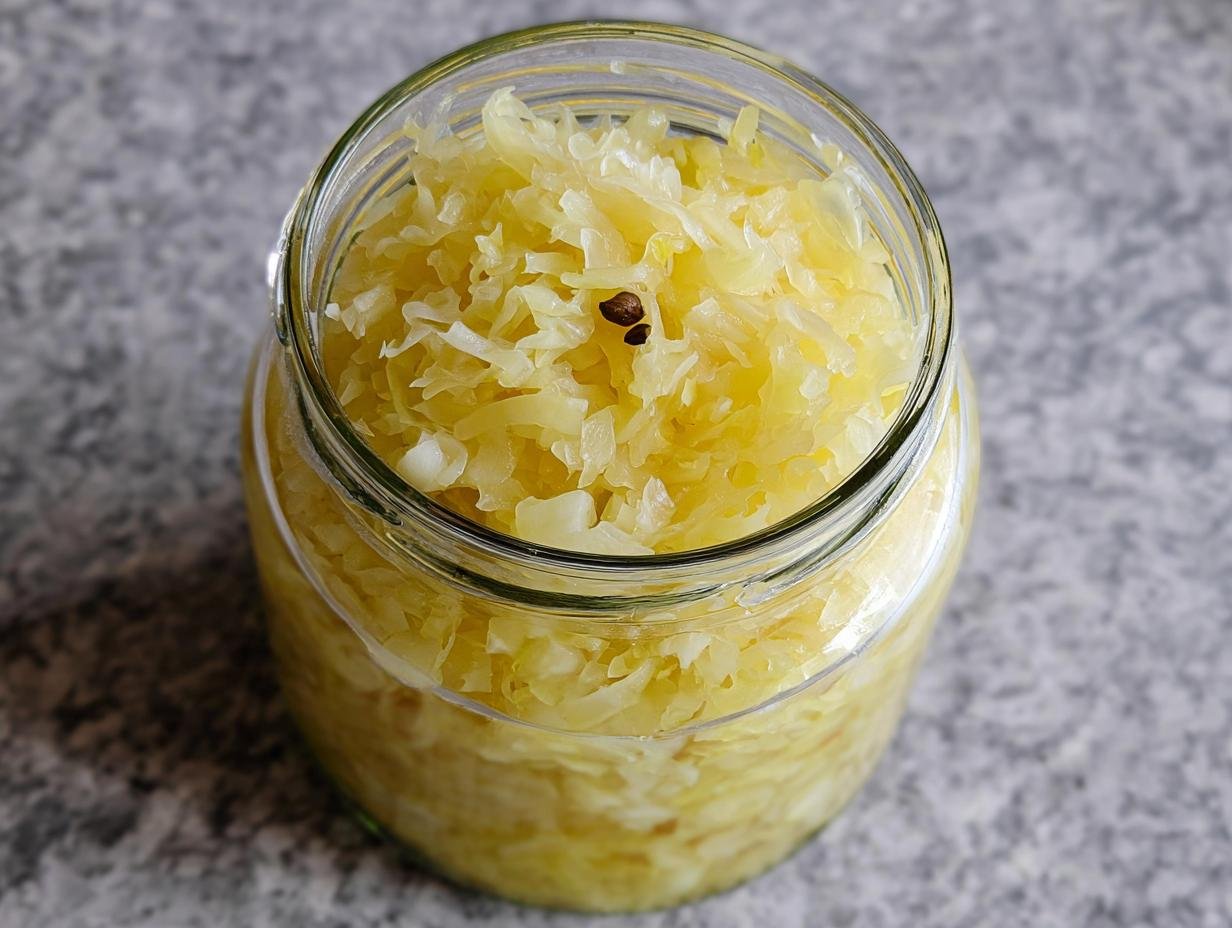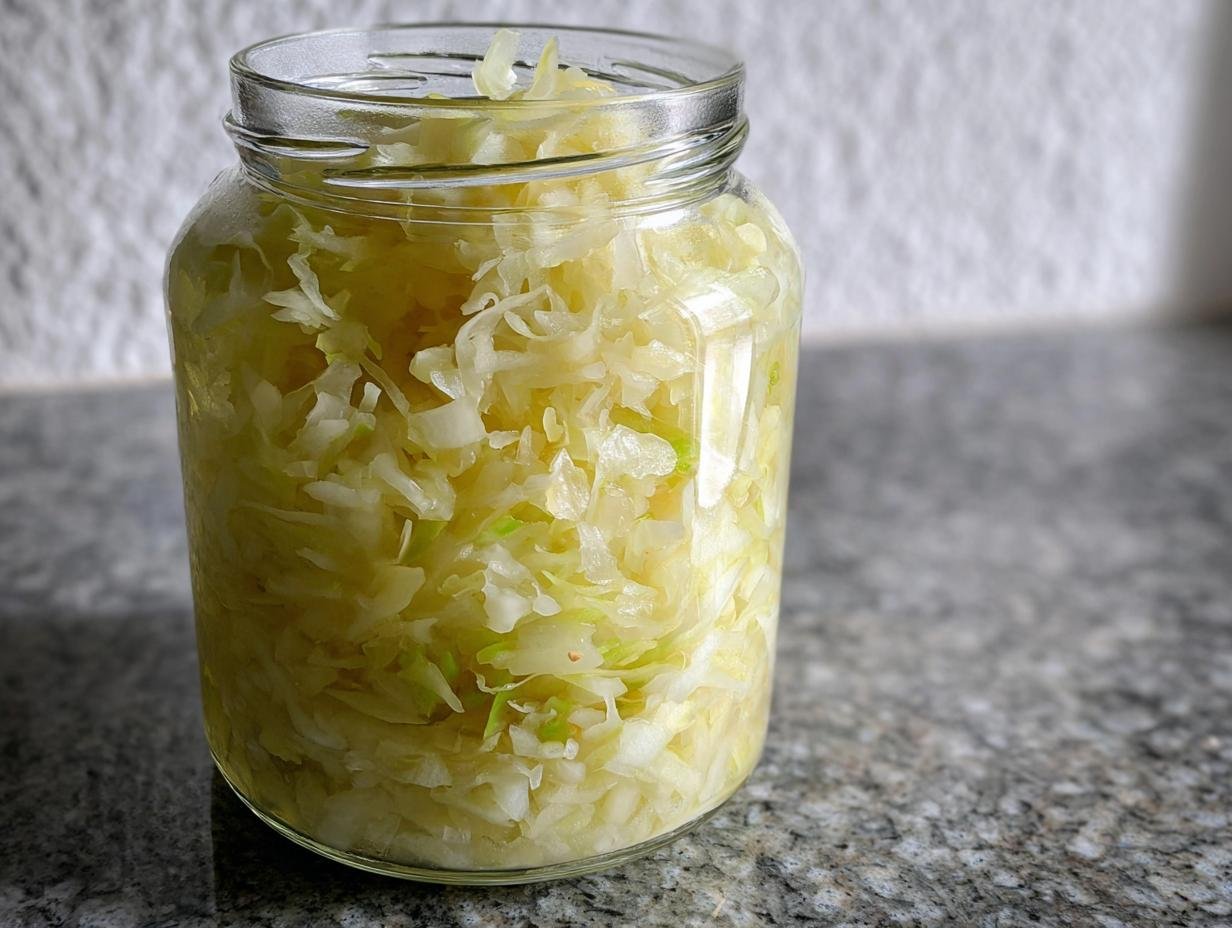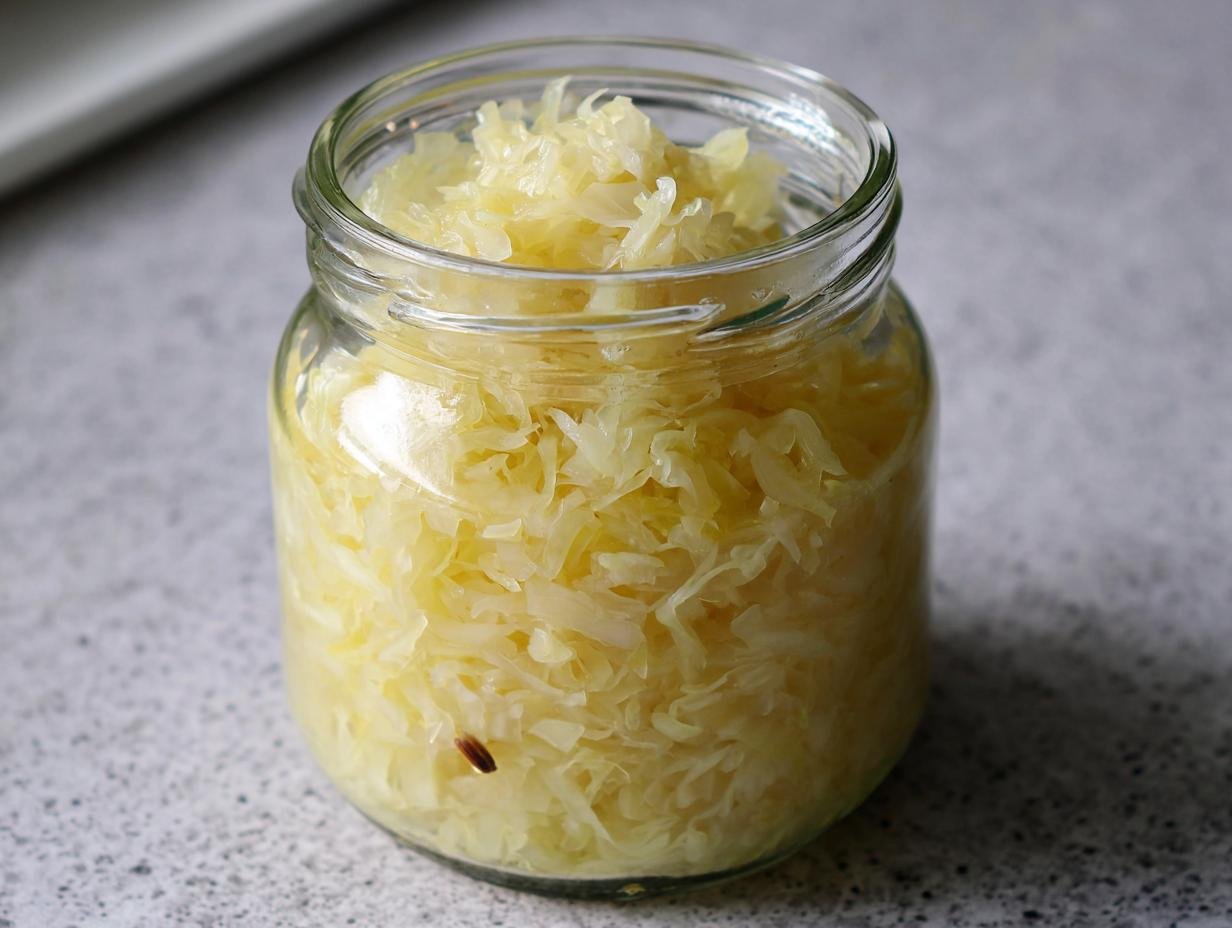Sauerkraut has a special place in my heart, and I’m so excited to share this easy way to make it at home. I still remember the first time I tasted truly authentic German sauerkraut – it was this incredible tangy, slightly sour crunch that completely changed my mind about what sauerkraut could be. Forget those bland, watery versions you find in most grocery stores! This homemade version, which is essentially just fermented cabbage, is bursting with flavor and goodness. It’s so simple, requiring just a couple of ingredients and a bit of patience, but the reward is a jar of probiotic-rich goodness that will elevate any meal. Let’s get cooking!

Why You’ll Love This Sauerkraut
You’re going to adore making this homemade sauerkraut. It’s incredibly simple and the results are fantastic!
- It’s packed with probiotics, making it great sauerkraut for gut health.
- The tangy flavor is perfect for sandwiches, sausages, and more.
- Making fermented cabbage at home is surprisingly easy and rewarding.
- It’s a fantastic way to boost your intake of vitamins and minerals.
- Enjoy the satisfying crunch and complex flavor of authentic sauerkraut.
- This recipe is budget-friendly compared to store-bought versions.
- It’s a versatile condiment that adds a unique zing to many dishes.
- Regular consumption supports a healthy digestive system, making it excellent sauerkraut for gut health.
Sauerkraut Ingredients
Gathering your ingredients for this simple homemade sauerkraut recipe is a breeze! You’ll only need two main components, but having a few optional additions can really elevate the flavor. The magic of making sauerkraut at home really comes down to the quality of your cabbage and the salt you use. We’re talking about basic, beautiful ingredients here!
- 1 medium head (1 kg) white cabbage – choose a firm, fresh head, and remove any bruised outer leaves.
- 1 Tbsp (18 g) salt – non-iodized sea salt or Himalayan salt is best, as iodine can interfere with the fermentation. This salt is crucial; it draws out the liquid from the cabbage to create the brine. It acts as our natural sauerkraut starter.
- Bay leaves (optional) – adds a subtle aromatic note.
- Caraway seeds (optional) – a classic addition for that traditional German flavor.
- Juniper berries (optional) – imparts a slightly piney, peppery taste.

How to Make Sauerkraut
Embarking on the sauerkraut making process at home is incredibly satisfying, and this recipe makes it super accessible. You don’t need fancy equipment, just a bit of patience and a keen eye. I love how the simple act of massaging salt into cabbage transforms it into something magical and probiotic-rich. It’s a truly rewarding kitchen adventure!
- Step 1: Prepare the Cabbage
First things first, ensure your workspace and all your tools are sparkling clean. This is vital for a successful fermentation. Remove the tough outer leaves from your cabbage head; you can save one to use later. Quarter the cabbage and carefully cut out the tough core from each piece. Now, it’s time to shred. Thinly slice the cabbage, aiming for about 1/8-inch (3mm) thickness. A sharp knife or a mandoline slicer works wonders here. Once shredded, weigh the cabbage. You’ll need salt equal to 2% of its weight – for a 1 kg head, that’s 20g of salt. Transfer the shredded cabbage into a large bowl and sprinkle the salt over it. Now, get your hands in there and massage the salt into the cabbage for about 5-10 minutes. You’ll feel the cabbage softening and see it releasing its own liquid. If it’s not releasing much liquid after a few minutes, let it sit for 10-15 minutes and then massage again.
- Step 2: The Fermentation Process
With your cabbage nicely softened and releasing liquid, it’s time to pack it into your jar. Grab a large mason jar – a wide-mouth one is easiest. Pack the shredded cabbage and its accumulated liquid into the jar as tightly as possible. Use a tamper or the end of a wooden spoon to press it down firmly. This helps to remove air pockets and ensures the cabbage stays submerged in its own brine, which is key to preventing spoilage during the sauerkraut fermentation. Don’t fill the jar to the very top; leave about 25% headspace for expansion during fermentation. If you like, you can add optional flavorings now – a bay leaf, a few caraway seeds, or juniper berries tucked in add wonderful depth.
- Step 3: Fermenting and Monitoring
To keep everything submerged, use a fermentation weight, a clean stone, or even a small ziplock bag filled with brine. You can also use one of the reserved outer cabbage leaves to help keep the shredded cabbage down. Cover the mouth of the jar with a clean cloth secured by a rubber band, or use a specialized airlock lid. Find a cool, dark spot for your jar, ideally between 64–72°F (18–22°C). Over the next 2–3 weeks, you’ll need to monitor your ferment. Daily, ‘burp’ the jar by briefly opening the lid to release any built-up gases. Also, press down on the cabbage with a clean utensil to ensure it remains submerged under the brine. If the liquid level seems low, you can top it up with a 2% saltwater brine (dissolve 2g salt in 100g water). You might notice some white scum on the surface; this is normal and can be skimmed off. The sauerkraut making process is all about these small checks!
Pro Tips for the Best Sauerkraut
I’ve learned a few tricks over the years that make my sauerkraut turn out perfectly every time. These tips are gold!
- Always use a clean jar and utensils; cleanliness is paramount to prevent mold.
- Ensure the cabbage stays completely submerged in its brine. This is the most critical step for successful sauerkraut fermentation.
- Don’t be afraid to taste your ferment as it progresses to find your ideal tanginess.
- If you don’t have fermentation weights, a small ziplock bag filled with brine works as a great substitute to keep the cabbage down.
What’s the secret to perfect sauerkraut?
The real secret to perfect sauerkraut is patience and ensuring the cabbage stays submerged. This simple technique, part of the best sauerkraut recipe, guarantees a clean fermentation and that signature tangy flavor.
Can I make sauerkraut ahead of time?
Absolutely! You can prepare your sauerkraut days or even weeks in advance. Once it’s reached your desired taste, just seal the jar tightly and store it in the refrigerator. It’s perfect for meal prep!
How do I avoid common mistakes with sauerkraut?
The most common mistakes involve the cabbage not staying submerged, leading to mold, or using iodized salt. Always check that your cabbage is under the brine, and stick to non-iodized salt for a healthy fermented cabbage.

Best Ways to Serve Sauerkraut
Once you’ve made your own delicious batch of sauerkraut, the fun really begins with how you serve it! This tangy, crunchy condiment is incredibly versatile and pairs beautifully with so many dishes. I love adding a generous dollop of this vibrant probiotic sauerkraut to my favorite meals. It’s fantastic piled high on a classic German bratwurst or a hearty Reuben sandwich, adding that essential zip. It also works wonders alongside roasted meats like pork or chicken, cutting through the richness with its acidity. Don’t be afraid to try it as a side for grilled fish or even mixed into potato salad for an unexpected twist!
Nutrition Facts for Sauerkraut
Understanding the nutritional profile of your homemade sauerkraut is helpful, especially when considering its health benefits. This wonderfully fermented cabbage is a low-calorie addition to your diet, packed with beneficial compounds. Remember that the exact values can vary slightly based on the specific type of cabbage and salt used, as well as the length of fermentation.
- Calories: 27
- Fat: 1g
- Saturated Fat: 1g
- Protein: 1g
- Carbohydrates: 3.9g
- Fiber: 2g
- Sugar: 3g
- Sodium: N/A
Nutritional values are estimates.
How to Store and Reheat Sauerkraut
Once your batch of sauerkraut has reached your desired level of tanginess after its initial sauerkraut fermentation period, it’s time to store it properly to keep it tasting great. I always let my sauerkraut cool down a bit after taking it out of its fermenting spot before moving it to its final storage container. The best way to store it is in clean, airtight glass jars or containers. This helps maintain its probiotic qualities and prevents it from absorbing other odors in your refrigerator. For the best quality, consume refrigerated sauerkraut within 3-4 weeks. If you want to keep it longer, it freezes beautifully! You can freeze it for up to 3 months. To reheat, simply transfer the desired amount to a small saucepan and warm it gently over low heat. Avoid boiling, as high heat can kill those beneficial probiotics.
Frequently Asked Questions About Sauerkraut
What is sauerkraut exactly?
Sauerkraut is essentially finely shredded raw cabbage that has been fermented by lactic acid bacteria. This traditional method of preserving vegetables, often called lacto-fermentation, creates that characteristic sour taste and crunchy texture. It’s a staple in many cuisines, particularly German, and is made with just cabbage and salt, though other spices are often added.
Is sauerkraut healthy?
Yes, sauerkraut is incredibly healthy! It’s a powerhouse of probiotics, which are beneficial bacteria crucial for gut health and digestion. It’s also packed with vitamins C and K, fiber, and antioxidants. While generally safe, some people might experience mild digestive upset due to its fiber and probiotic content, so it’s good to start with small portions if you’re new to fermented vegetables.
How long does sauerkraut fermentation take?
The time it takes for sauerkraut fermentation can vary, but typically, you’re looking at 2 to 3 weeks at room temperature (around 64–72°F or 18–22°C). The exact duration depends on the temperature and your personal preference for tanginess. Warmer temperatures speed up fermentation, while cooler temperatures slow it down. You can taste it periodically to determine when it’s ready for you!
Variations of Sauerkraut You Can Try
Once you’ve mastered the basic homemade sauerkraut recipe, you’ll find there are so many fun ways to mix things up! Experimenting with different flavors and ingredients is part of the joy of making your own cultured cabbage. These variations add new dimensions to this classic fermented food.
- Spicy Sauerkraut: Add a pinch of red pepper flakes or a sliced jalapeño to the jar along with the cabbage and salt. This gives a lovely kick to your fermented vegetables.
- Beet Sauerkraut: Toss in a diced beet or two with your shredded cabbage. This not only adds a beautiful vibrant color but also a subtle earthy sweetness to your sauerkraut.
- Apple Sauerkraut: For a hint of sweetness, add a chopped apple (like Honeycrisp or Fuji) to the mix. It complements the tanginess of the cabbage wonderfully.
- Ginger-Garlic Sauerkraut: Incorporate some minced fresh ginger and garlic cloves for a pungent, aromatic twist that’s incredibly delicious with this tangy cultured cabbage.

Sauerkraut: 1 Amazing Gut Health Boost
- Total Time: 20 minutes + 2-3 weeks fermentation
- Yield: Approximately 1 kg 1x
- Diet: Vegetarian
Description
Learn how to make authentic German sauerkraut at home with this simple, two-ingredient recipe. This fermented cabbage is packed with probiotics and offers a tangy crunch to your meals.
Ingredients
- 1 medium head (1 kg) white cabbage (outer leaves removed)
- 1 Tbsp (18 g) salt (non-iodized sea salt or Himalayan salt recommended)
- Bay leaves (optional)
- Caraway seeds (optional)
- Juniper berries (optional)
Instructions
- Ensure all utensils and tools are clean. Remove outer leaves of the cabbage, save one. Quarter the cabbage and cut out the core.
- Shred the cabbage thinly (about 1/8-inch or 3mm) using a knife or mandoline.
- Weigh the shredded cabbage. Calculate the salt needed based on 2% of the cabbage’s weight.
- Transfer the shredded cabbage and salt to a large bowl. Massage with clean hands for 5-10 minutes until it releases significant liquid. Let it sit for 10-15 minutes before massaging if needed to speed up liquid release.
- Pack the cabbage and its liquid tightly into a large mason jar, using a pestle or tool to ensure it’s submerged. Do not overfill; leave headspace for expansion.
- Add optional flavorings like bay leaves, caraway seeds, or juniper berries.
- Weigh down the cabbage with fermentation weights or clean stones in a ziplock bag to keep it fully submerged. A reserved cabbage leaf can help.
- Cover the jar with a clean cloth secured with a rubber band, or use an airlock lid.
- Ferment in a cool, dark place (ideally 64–72°F / 18–22°C) for 2–3 weeks. ‘Burp’ the jar daily to release gas and press down the cabbage to keep it submerged.
- If the liquid level is low, top up with a 2% saltwater brine (2g salt per 100g water). Skim off any scum that appears on the surface.
- Once the sauerkraut reaches your desired tanginess, screw on the cap and refrigerate. For increased probiotics, you can continue fermenting in the refrigerator for another 2-3 weeks.
Notes
- Cleanliness is crucial to prevent mold and unwanted bacteria.
- Ensure the cabbage stays submerged in its brine to prevent spoilage.
- If insufficient brine is released, use a 2% saltwater brine to top it up.
- Salt is essential for preservation and fermentation.
- Experiment with fermentation times by making two jars simultaneously to find your preferred level of sourness.
- Do not overfill jars; leave about 25% headspace.
- Consider adding smoked paprika for extra flavor after fermentation.
- Prep Time: 20 minutes
- Cook Time: 0 minutes
- Category: Fermented Foods
- Method: Lacto-fermentation
- Cuisine: German
Nutrition
- Serving Size: Approx. 100g
- Calories: 27
- Sugar: 3g
- Sodium: N/A
- Fat: 1g
- Saturated Fat: 1g
- Unsaturated Fat: N/A
- Trans Fat: 0g
- Carbohydrates: 3.9g
- Fiber: 2g
- Protein: 1g
- Cholesterol: 0mg
